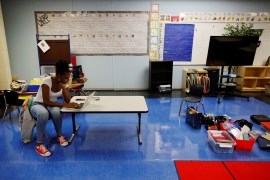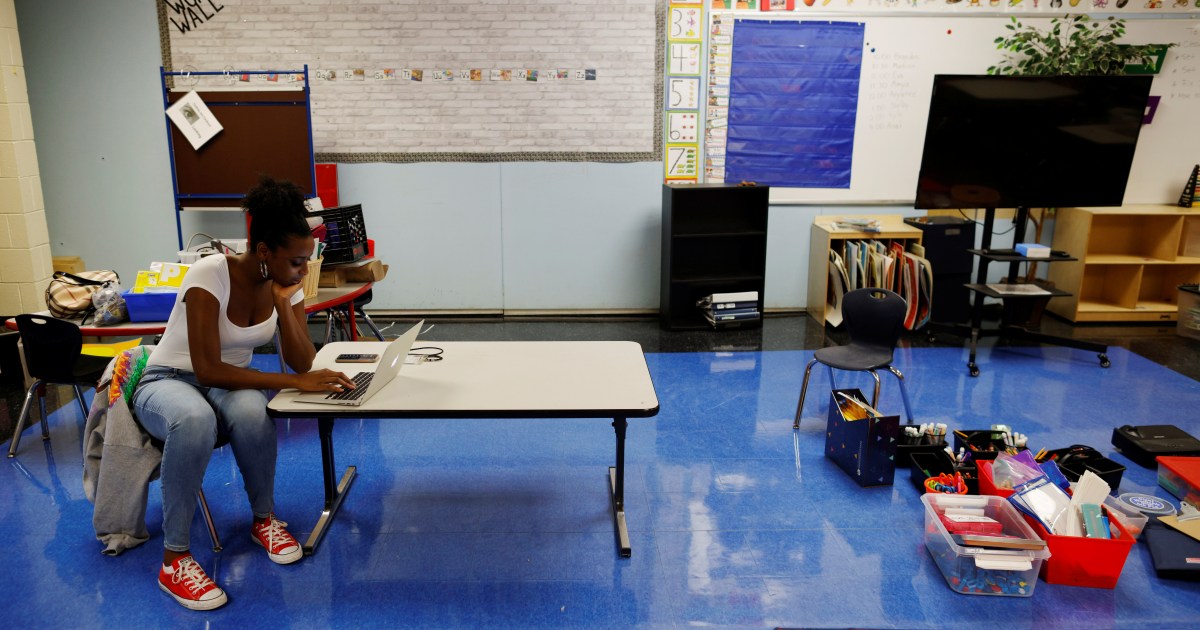
News stories about national teacher shortages have been grabbing high-profile headlines in recent weeks. Many signals point to a teacher workforce in crisis, leading observers to conclude teachers have grown tired of nonstop learning recovery and being caught in the crossfire of national culture wars.
But are these reports of a teacher crisis real or just hysterics? There’s a diversity of opinion on this issue, even among education scholars who closely study teachers. Even before the pandemic, scholars have been offering evidence for and against the reality of catastrophic levels of teacher shortages.
We invited three education scholars to weigh in on this question and offer their recommendations on relieving staffing pressures now and in the future. Emma García is a Senior Researcher at the Learning Policy Institute; Matthew Kraft is an Associate Professor of Education at Brown University; and Heather Schwartz is the director of the Pre-K to 12 educational systems program and a Senior Policy Researcher at the RAND Corporation.
Question 1: Is the U.S. facing a critical shortage of teachers in its public schools?
García: The news headlines are correct: This year, all 50 states have reported shortages in at least one subject area. Of course, shortages also vary substantially across states and districts, largely due to differentials in pay and working conditions. But one thing remains consistent: shortages of well-prepared teachers have historically been most severe in schools that serve larger numbers of students from low-income families and students of color and in subjects with greater opportunity costs, like special education, mathematics, and science.
The U.S. has experienced recurring teacher shortages for decades—a condition the COVID-19 pandemic has only worsened. Shortages have been driven by a shrinking teacher education pipeline, high rates of turnover, and increased demand as districts replaced positions cut during the Great Recession and expanded staffing using federal COVID-19 relief funding to address increased vacancies and to support learning needs. Understanding this is important in addressing current shortages.
Is this a “critical” problem? Absolutely. When schools can’t hire qualified teachers for vacant positions, they may increase class sizes, cancel course offerings, or hire uncertified individuals to fill positions. High rates of underprepared teachers in a district decrease student achievement and, since they are more than twice as likely to leave the profession as fully prepared novices, exacerbate teacher turnover. Teacher turnover also harms student achievement, perpetuates unequal opportunities to learn, impacts teacher effectiveness, erodes the profession’s appeal, and drains district resources.
Kraft: Yes, I see the current situation as critical, though this is as much a value-based as an evidence-based question. From a value-based perspective, our inability to ensure that every public school is fully staffed with qualified teachers is a crisis. Focusing on the aggregate numbers alone can inure us to the inherent inequities of localized teacher shortages.
From an evidence-based perspective, the answer is complicated. My colleague Josh Bleiberg and I began searching for concrete evidence over a year ago and found that, as a nation, we lack reliable, timely, and detailed data on K-12 teacher supply and demand. Without it, we must rely on incomplete measures to gauge the health of one of the largest and most important professions in our country. This is unacceptable, leading to the uncertainty of the present moment.
But we don’t need perfect data to know that acute teacher staffing challenges exist—schools and districts can simply tell us and they are increasingly doing so. While some might question the severity of our current situation, a recent estimate put the total number of vacant teaching positions and underqualified teachers at over 200,000, nationally; that is a critical shortage.
We should also be deeply concerned about the profession when teachers repeatedly tell us they are burnt out and considering quitting, even if none of them ever do. A mass exodus of teachers has not happened (yet), but ignoring teachers’ voices is partly how we got here. All kids deserve teachers that are fully invested, not ones so overwhelmed that they understandably have one foot out the door.
Schwartz: Based on district leaders’ projections, teacher shortages will be widespread, but not acute, for most districts in the 2022–2023 school year. As of March 2022, 58 percent of a nationally representative set of district leaders anticipated a “small shortage” of teachers and another 17 percent anticipated a “large shortage.”
These projections suggest current teacher shortages are less acute than they were during the 2021–2022 school year, when a higher proportion of districts reported shortages. There are at least three likely reasons why. First, about three quarters of districts nationally ramped up hiring last year (with the support of federal stimulus funds) and many are still hiring to expand the number of staff they employ above pre-pandemic levels in some job categories—most commonly substitute teachers, paraprofessionals, and tutors. Second, student enrollments have declined in many districts, which can reduce the number of teachers needed. And third, there has not been a mass exodus of teachers from the profession thus far in the pandemic. There have been some modest increases in teacher turnover in some states recently, and the serious decline of teacher morale suggests that turnover could still increase.
That is the national picture of teacher shortages, but the generalization has its limits because there is no unified, national teacher labor market. States’ and districts’ shortages varied substantially in 2021–2022, as Nguyen, Lam, and Bruno effectively show. Therefore, some districts—especially those in high-need settings—are likely experiencing an acute shortage this year, while others are not.
Question 2: What actions can policymakers and education leaders take to stabilize the teacher workforce now?
García: Research has identified key drivers of teacher shortages and offers evidence-based solutions to recruit, retain, and strengthen the workforce. Unfortunately, given current shortfalls, some states and districts are bringing in more underprepared teachers: a recipe for continued turnover and growing achievement gaps. Though well-intended, these short-term fixes will only perpetuate ongoing shortages. Others, however, are leveraging state money and federal relief dollars to stabilize and strengthen their educator workforce through long-term solutions such as competitive compensation, investments in preparation, and improved working conditions. Policymakers and education leaders would be wise to follow their lead.
Kraft: The roots of the problem are deep, so any immediate solution will be ephemeral and incomplete. In the short-term, districts could use federal aid to offer one-time signing bonuses for new teachers and those willing to work in hard-to-staff schools. Temporarily relaxing licensure requirements for teachers (and substitutes) is likely a necessary pill to swallow even though it runs counter to a long-term solution aimed at raising the status of the profession. Failing to do so has led some schools to close for weeks on end and to adopt 4-day weeks, a demonstrably bad situation for students.
Schwartz: While teacher turnover hasn’t significantly risen throughout the pandemic, teacher morale has steadily and significantly eroded. Teacher pipelines were already thin in some geographic areas and specializations, and poor morale further discourages prospective teachers from entering the profession. District leaders and principals should acknowledge how prevalent job stress and burnout are among teachers and go on a listening tour of teachers to learn the main sources of stress in the job and what teachers suggest could be done to mitigate it. A combination of improved pay and working conditions could be important levers to boost morale and stabilize the workforce.
Question 3: What do you recommend to strengthen the supply of teachers over the long term?
García: Key, evidence-based actions to meaningfully and substantially strengthen the teacher workforce include:
- Offering Competitive Compensation. Most teachers experience a “pay penalty,” which hit a new high in 2021 when salaries averaged 23.5 percent less for teachers compared against their college-educated peers. In pandemic-era surveys, the top reason for leaving was insufficient pay commensurate with the risk or stress of the job. Better compensation can improve hiring and student outcomes, reducing achievement gaps.
- Strengthening Teacher Preparation. Shortages can be reduced rapidly if districts hire better-prepared teachers. This can be accomplished through loan forgiveness and scholarship programs, which help overcome student debt burdens, and through teacher residencies that prepare a more diverse cadre of teachers who are more effective and more likely to stay.
- Improving Teaching and Learning Conditions. Fifty-five percent of leavers cited dissatisfactions with teaching as a reason for leaving, including testing and accountability pressures, inadequate administrative support, the lack of opportunities for input and advancement, among other working conditions. Many of these factors have only worsened during the pandemic.
Teaching is the profession on which all other professions depend. Research-based investments in the teaching workforce not only benefit students and foster high-quality learning for all, but they benefit society as well.
Kraft: We should focus on creating the teaching profession we want for our children. First, we need to pay teachers more—and 72 percent of the public agrees. In some states, wages are so low that teachers are being pushed out of the middle class. Raising wages across the board, however, won’t get more teachers in the schools and subjects where we need them most. This requires targeted salary increases for hard-to-staff settings, which will require both more progressive state funding formulas and district-union collaboration to redesign salary schedules and allow for differentiated compensation. We also need targeted efforts to build teacher supply in areas that lack a local teacher pipeline; Grow Your Own programs are one promising approach.
But we cannot settle for just fully staffed schools; we need the very best educators our nation can produce. Achieving this means elevating the status of the teaching profession—a larger, generational task. More talented young graduates would choose teaching if there were a career ladder with distinguishable stages and widely recognizable promotions they could earn to serve as master educators or school-based instructional leaders. Teachers might also advance this cause by taking greater ownership over peer evaluation and review efforts to ensure the profession maintains high standards.
None of this will happen overnight. But if we start aligning education policies with our values, it is all possible.
Schwartz: Offering financial incentives like loan forgiveness could help to draw more candidates into the teacher preparation pipeline and thereby increase the long-term teacher labor supply. Reducing the cost of teacher preparation could also help develop a more racially diverse teacher corps, as my colleagues and I document in forthcoming work. District and state leaders should also work with preparation programs to proactively recruit prospective teachers into the job categories and specialties with the largest number of unfilled vacancies and underqualified staff.
But money and recruiting aren’t enough. When we surveyed former public school teachers in December 2020 about why they left the profession, stress was the most common top reason for leaving, regardless of whether teachers left before or during the pandemic. In fact, stress was almost twice as common a reason for leaving as insufficient pay. For former teachers who remained in the education sector, more flexibility was the most common attribute that attracted them to their new jobs. District leaders should work with teachers to help design jobs that are less stressful and offer greater flexibility, which could improve retention and attract more candidates. Given how important social networks are for teachers as they find positions, improving working conditions could be a critical lever in attracting new candidates.


